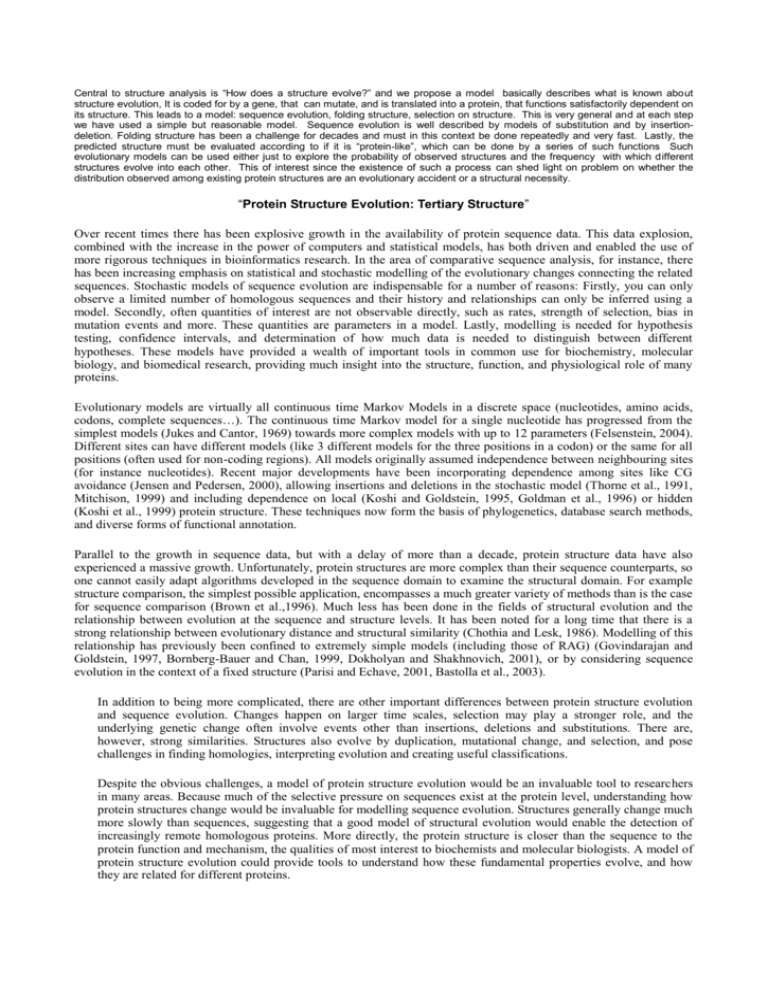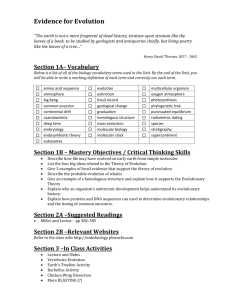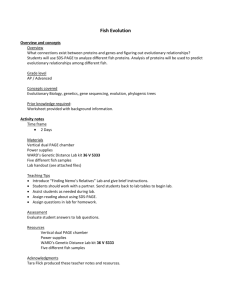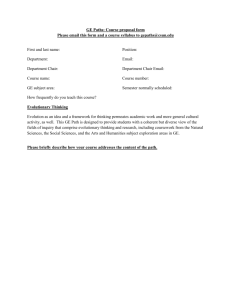Modelling evolution of protein tertiary structure
advertisement

Central to structure analysis is “How does a structure evolve?” and we propose a model basically describes what is known about structure evolution, It is coded for by a gene, that can mutate, and is translated into a protein, that functions satisfactorily dependent on its structure. This leads to a model: sequence evolution, folding structure, selection on structure. This is very general and at each step we have used a simple but reasonable model. Sequence evolution is well described by models of substitution and by insertiondeletion. Folding structure has been a challenge for decades and must in this context be done repeatedly and very fast. Lastly, the predicted structure must be evaluated according to if it is “protein-like”, which can be done by a series of such functions Such evolutionary models can be used either just to explore the probability of observed structures and the frequency with which different structures evolve into each other. This of interest since the existence of such a process can shed light on problem on whether the distribution observed among existing protein structures are an evolutionary accident or a structural necessity. “Protein Structure Evolution: Tertiary Structure” Over recent times there has been explosive growth in the availability of protein sequence data. This data explosion, combined with the increase in the power of computers and statistical models, has both driven and enabled the use of more rigorous techniques in bioinformatics research. In the area of comparative sequence analysis, for instance, there has been increasing emphasis on statistical and stochastic modelling of the evolutionary changes connecting the related sequences. Stochastic models of sequence evolution are indispensable for a number of reasons: Firstly, you can only observe a limited number of homologous sequences and their history and relationships can only be inferred using a model. Secondly, often quantities of interest are not observable directly, such as rates, strength of selection, bias in mutation events and more. These quantities are parameters in a model. Lastly, modelling is needed for hypothesis testing, confidence intervals, and determination of how much data is needed to distinguish between different hypotheses. These models have provided a wealth of important tools in common use for biochemistry, molecular biology, and biomedical research, providing much insight into the structure, function, and physiological role of many proteins. Evolutionary models are virtually all continuous time Markov Models in a discrete space (nucleotides, amino acids, codons, complete sequences…). The continuous time Markov model for a single nucleotide has progressed from the simplest models (Jukes and Cantor, 1969) towards more complex models with up to 12 parameters (Felsenstein, 2004). Different sites can have different models (like 3 different models for the three positions in a codon) or the same for all positions (often used for non-coding regions). All models originally assumed independence between neighbouring sites (for instance nucleotides). Recent major developments have been incorporating dependence among sites like CG avoidance (Jensen and Pedersen, 2000), allowing insertions and deletions in the stochastic model (Thorne et al., 1991, Mitchison, 1999) and including dependence on local (Koshi and Goldstein, 1995, Goldman et al., 1996) or hidden (Koshi et al., 1999) protein structure. These techniques now form the basis of phylogenetics, database search methods, and diverse forms of functional annotation. Parallel to the growth in sequence data, but with a delay of more than a decade, protein structure data have also experienced a massive growth. Unfortunately, protein structures are more complex than their sequence counterparts, so one cannot easily adapt algorithms developed in the sequence domain to examine the structural domain. For example structure comparison, the simplest possible application, encompasses a much greater variety of methods than is the case for sequence comparison (Brown et al.,1996). Much less has been done in the fields of structural evolution and the relationship between evolution at the sequence and structure levels. It has been noted for a long time that there is a strong relationship between evolutionary distance and structural similarity (Chothia and Lesk, 1986). Modelling of this relationship has previously been confined to extremely simple models (including those of RAG) (Govindarajan and Goldstein, 1997, Bornberg-Bauer and Chan, 1999, Dokholyan and Shakhnovich, 2001), or by considering sequence evolution in the context of a fixed structure (Parisi and Echave, 2001, Bastolla et al., 2003). In addition to being more complicated, there are other important differences between protein structure evolution and sequence evolution. Changes happen on larger time scales, selection may play a stronger role, and the underlying genetic change often involve events other than insertions, deletions and substitutions. There are, however, strong similarities. Structures also evolve by duplication, mutational change, and selection, and pose challenges in finding homologies, interpreting evolution and creating useful classifications. Despite the obvious challenges, a model of protein structure evolution would be an invaluable tool to researchers in many areas. Because much of the selective pressure on sequences exist at the protein level, understanding how protein structures change would be invaluable for modelling sequence evolution. Structures generally change much more slowly than sequences, suggesting that a good model of structural evolution would enable the detection of increasingly remote homologous proteins. More directly, the protein structure is closer than the sequence to the protein function and mechanism, the qualities of most interest to biochemists and molecular biologists. A model of protein structure evolution could provide tools to understand how these fundamental properties evolve, and how they are related for different proteins. The approach: Making a useful stochastic model of protein structure evolution involves solving several hard problems. First, a tractable model must be defined, then probability of observed structures must be evaluated, and finally, parameter estimation and model testing need to be carried out. The continuous-time Markov models of evolution used for other biological phenomena share common features that could guide model building for protein structure evolution. Such a model is defined by the various processes that can occur with their respective probabilities of occurrence. Given the difficulty of this modelling and associated calculations, it is important to realize that simplifications can be made both in the evolutionary process and how to represent a protein leading to a hierarchy of modelling problems, dependent on how realistic the model is. A first most realistic version stems from a full description of how sequences evolve, are translated, the protein folded and then the structure selected against. A second more simplified version will work on proteins represented as topologies and lengths assigned to all secondary elements. Starting with the most realistic model, evaluating the likelihood of a single step in protein structure evolution can be viewed as a three stage process: 1. A traditional genetic event must occur. This would be a substitution or insertion-deletion which could be modelled according to known sequence processes. On much longer time scales other events such as fusion, duplication, and inversion might play a role. 2. This change would give rise to a new protein sequence that might fold into a new structure. Although it is likely to be highly similar to the previous structure, this new structure must still be predicted. This prediction step would have to be done very efficiently as it will be repeated many times in the simulation of an evolutionary path. 3. The viability of the resulting sequence would have to be evaluated using a fitness function evaluating how likely the protein is to fold and be functional. Such fitness functions, while highly simplified, do exist, based on how “protein like” the predicted structure is. The model draws heavily on already established models of sequence evolution. The major problems arise due to the size of the structure space, the number of steps a structure would have to traverse to be transformed into its homologous counterpart, and the number of possible paths leading from one protein to another. This leads to a computationally expensive algorithm necessitating multiple protein structure prediction steps. References Brown, N., C.Orengo and Taylor (1996) “ A Protein Structure Comparison Methodology“ Computers Chem. 20.359380. Chothia, C. and Lesk, A. M. (1986) The relationship between the divergence of sequence and structure in proteins. EMBO J., 5, 823-826. Goldman N., Thorne J and Jones (1996) "Using Evolutionary trees in protein secondary structure prediction and other comparative sequence analyses" J. Mol.Biol. 263.196-208. Jukes,T.H. and Cantor,CR (1969) "Evolution of Protein Molecules" pp21-132 in Mammalian Protein Metabolism vol. III ed MN Munro. Academic Press. New York. Lin, K. and Taylor, W. R. and Klienjung, J. and Heringa, J. "Testing homology with (Cao et al.): A contact-based Markov model of protein evolution", "J. Compu. Biol. Chem.",27",93--102","2003" Song, Y and J.J. Hein (2003) “Parsimoneous Reconstruction of Evolution and Haplotype Blocks” (WABI03, Hungary. Lecture Notes in Bioinformatics vol.2812. p287-302) Taylor, W. R. and Munro, R. E. J. and Petersen, K. and Bywater, R. P. Ab initio modelling of the N-terminal domain of the secretin receptors", Comp. Biol. Chem.27.103--114", "2003" Taylor, W. R. and Jonassen, I.", "A Structural Pattern-based Method for Protein Fold Recognition", "Proteins: struc. funct. gene.", " Proteins 56:222-234" Taylor, W. R. and Jonassen, I Thorne, JL, Kishino, H. and J. Felsenstein An Evolutionary Model for Maximum Likelihood Alignment of DNA Sequences. In Journal of Molecular Evolution, 33:114-124, 1991.







